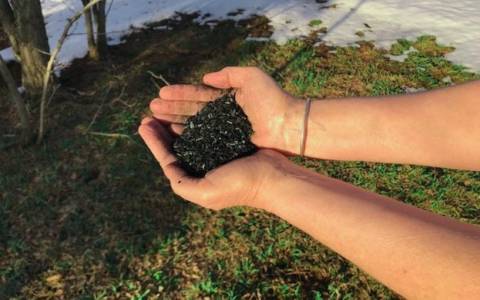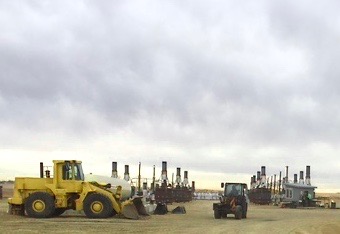Written by Janis Hallowell
I first heard the word biochar in January, 2021 in a Zoom meeting. I had never heard or read it before. I gathered that it had something to do with carbon farming but I didn’t know what that was, exactly, either. I started asking around. My farmer neighbors didn’t know what it was. A large-scale, long-time organic gardener friend didn’t know about it. Neither did a chemist friend nor a geologist friend. I began to research biochar and what I have been discovering has been surprising and life-altering.
What is biochar and why is it important?
Biochar is the product of burning organic material (biomass) at high temperatures in the absence of oxygen (pyrolysis). Biochar binds or sequesters carbon reliably for hundreds of years and possibly for millennia. The important thing here is that sequestered carbon is carbon that no longer goes into the atmosphere as carbon dioxide to increase global warming.
In addition, beneficial microbes, fungi, and earthworms proliferate in soil that contains biochar. It absorbs toxins, regulates humidity, and greatly increases soil quality, fertility, and yield in agriculture. That’s at least a win-win.
There’s more: It improves the health of animals when used in feed. Pyrolyzing dead wood or beetle kill from forests to make biochar helps prevent forest fires. It holds promise as a clean ingredient in everything from concrete to asphalt to plastic. It can be used to purify water and neutralize toxins in applications beyond agriculture. For example, sewer sludge can be pyrolyzed and made into biochar, improving waste management and burning up harmful bacteria and chemicals while sequestering massive amounts of carbon. It could even be used to plug orphan fracking wells, binding toxic emissions from them. And, the heat generated from pyrolysis is a source of clean, renewable energy that can be used to heat homes, schools, nurseries etc. It turns out that biochar’s wins are many and layered.
In fact, biochar is the dark horse in the race to fix the climate problem. Up until now it hasn’t been on the radar of most people who aren’t connected to the biochar industry, but that is changing.
In order to reach the goals set by the Paris Climate Accord we can no longer rely on transitioning from fossil fuels to renewables alone. Getting to zero emissions will not be enough. We will only meet the Paris Accord target by also engaging in the removal and sequestration of carbon. In October of 2020 the Intergovernmental Panel on Climate Change published a corroborating report: that we will not limit global warming to an increase of 1.5 degrees Celsius without significant carbon removal.
To be clear, we need to transition from all fossil fuels as completely as possible, and as soon as possible. We need recycling and composting and forestation. But we also need to sequester carbon. And biochar is the most reliable, safe, and imminently possible of the known carbon capture and sequestration technologies.
It sounds good, but I am skeptical by nature and questions and suspicions arose.
Is biochar too good to be true?
The experts I contacted all said that there is no silver bullet in fighting climate change, but biochar holds great promise to help, along with better land management and a complete transition to renewables. Most agree that it will need regulation, as all new resources do.
We need legislation, and it is starting to happen. In early March the House released a new draft of the CLEAN Future Act, which, if passed, will push Climate action forward and could provide help for carbon capture technologies.
Why haven’t we been hearing more about this?
Gordon West of Trollworks (manufacturers of bio-energy and carbon capture sequestration systems) says that though the science is hard for most to understand, it’s also that to use biochar effectively we have to adjust our systems of agriculture, economics, society, energy, and more. Kathleen Draper of the International Biochar Initiative says that the idea of burning something to cool down the earth is a paradox that’s difficult to embrace.
If biochar is so great, where is the entrepreneurial interest?
In February, Microsoft made an announcement of its support for three biochar companies in Germany, Finland, and Australia through carbon credit via Puro. This is huge. Think what you will about Microsoft and carbon credits but in the money world, where Microsoft goes, others will follow. Their involvement will grease the wheels for more investors in biochar, which will in turn increase production, public education, public acceptance, bring about more investing, and so on, building the cycles of awareness and funding. Also in February, Exxon announced that it is investing 3 billion over the next five years in energy projects, including carbon capture. And Elon Musk has launched a $100 million prize for the best carbon capture technology.
Money is oxygen to technology. We need business people to make research and use of biochar a mainstream concern in order to achieve the scale needed to be a major technology in the climate fight. And that seems to be starting to happen.
Things are moving fast in biochar right now, and not a moment too soon.
Want to learn more? Read: Burn by Albert Bates and Kathleen Draper
Want to get involved? 1. Talk to people you know. Ask them if they’ve heard of biochar. 2. Look into using biochar in your garden. 3. Ask your nursery if they carry it and if they don’t, ask them to look into Biochar Now, suppliers of the only USDA and EPA approved biochar in the States. 4. Write to your legislators and ask them to support more legislation for carbon removal and sequestration – and use the term biochar. 5. Join the International Biochar Initiative and subscribe to their newsletter.
Sources:
Kathleen Draper, International Biochar Initiative
Ron Larson, United States Biochar Initiative
Gardening With Biochar by Jeff Cox
Want to support regenerative agriculture and land use pratcies in Colorado? Join our mailing list to stay updated on ways to take action. Click here to sign up!



